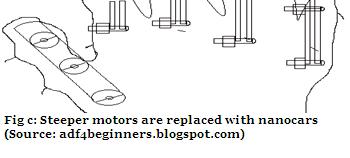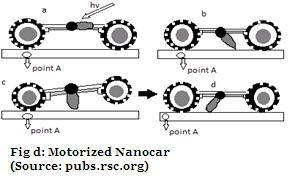Title: NANOCAR INTO THE ROBOTICS
Authors: Bidisa Sarkar & Anirban Kundu, 1st Year MBA
College/Institution: Supreme Knowledge Foundation Group of Institutions
ABSTRACT
Material Science research is now entering a new phase where the structure and properties of materials can be investigated, characterized and controlled at the nanoscale. New and sometimes unexpected material properties appear at the nanoscale, thus bringing new excitement to this research field. In this discussion, special emphasis will be given to one-dimensional nanotubes and nanowires because they exhibit unusual physical properties, due to their reduced dimensionality and their enhanced surface/volume ratio. These unusual properties have attracted interest in their potential for applications in novel electronic, optical, magnetic and thermoelectric devices.
Nanotechnology is the area of research and development that is truly multidisciplinary. Research at the nanoscale is unified by the need to share knowledge on tools and techniques, as well as information on the physics affecting atomic and molecular interactions in this new realm.
Introducing the nanotechnology into the field of robotics we can achieve a realistic movement which is a dream of the human for more than five years. By introducing this nervous system to the robots we get exactly two advantages (a) we can pass information (b) we can control the movements of the cars reaching the actual part where the movement are caused, both at the same time. Thus we need to gain some knowledge about the nano technology and from these we shall define what the nanocars means next we will clearly get an idea about the introduction of the nanocars into the neuron system.
ABBREVIATIONS
MIS: Micro Information Seekers
MEMS: Micro-electromechanical System
IT: Information Technology
INTRODUCTION TO NANOTECHNOLOGY
From converting sunlight into power to clean oceans, to monitor thermal environment, and to sensors in the form of biochips built into the human body performing as lifesavers by self-monitoring and guarding, nanotechnology assures us a lot more!
Stone Age, Bronze Age, Iron Age, Silicon Age, and next what? Nevertheless to say, we are well in to the Nanotech Age, where materials are just getting smarter day by day. There would be sensors embedded in almost all walks of life. Each element would be smart enough to repair itself as and when required. All this would be possible by manipulating matter at the molecular scale.
Scientists will now like to understand how simple atoms and molecules come together and arrange themselves to form complex systems, such as living cells that make life possible on earth. This approach deals with how complex systems are built from simple atomic-level constituents who result in nanoscience and nanotechnology. In simple, it is the study of properties of a few tens of atoms in a space of less say 50nm. Manufactured products are made from atoms. The properties of those products depend on how those atoms are arranged. If we rearrange the atoms in coal we can make diamond. If we rearrange the atoms in sand we can make computer chips. If we rearrange the atoms in dirt, water and air we can make potatoes. Almost any manufactured product could be improved, often by several orders of magnitude, if we could precisely control its structure at the molecular level. We often want our products to be light and strong.
WHAT IS NANOTECHNOLOGY?
Nanotechnology is a molecular manufacturing or, more simply, building things the size of one atom or molecule with programmed precision. It involves working with matter at scale of one- billionth of a meter.
Nanoscience is concerned with nonmaterial’s that have at least one of three dimensions of about 1 to 10 nanometers. The word ‘nano’ comes from the Greek word “nanos” meaning ‘dwarf’. The term nano is the factor 10-9 or one billionth. Nanotechnology is that area of science and technology where dimensions and tolerances in the range of 0.1nm to 100 nm play a critical role. Nanotechnology can best be considered as a ‘catch-all’ description of activities at the level.
Nanotechnology is an anticipated manufacturing technology giving through, inexpensive control of the structure of matter. The term has sometimes been used to refer to any technique able to work at a submicron scale here it is used in the more usual sense of general control of the structure of matter on a nanometer scale-that is, a broad ability to control the arrangement of atoms. This ability will require development of devices termed ‘assemblers’.
NANOMACHINES
The idea of nanotechnology is therefore to master over the characteristics of matter in an intelligent manner to develop highly efficient systems. However, this is a big challenge to technology as to how to build material in bulk form this way. It will be easy if one can learn through bioscience how the nature does it. Proteins are molecular machines that routinely manipulate individual atoms. Synthesis of building blocks of proteins can provide us an appropriate technology for making nanomaterials in bulk form. Molecular nanotechnology draws on cutting-edge advances in physics, chemistry, biology and computer science to build structures measured in nanometers.
Though we haven’t reached that omnipotent stage of evolution, we still have plenty of nanotech applications, from biosensors in the human body to intelligent systems embedded in real-time cars and airplanes calculating the wear and tear on engine life, everyday stain-resistant clothes, super telecommunication systems, and not to forget ‘smart dust’.
NANOTECHNOLOGY – MEMS
Micro-electromechanical system (MEMS) combines computers with tiny mechanical devices such as sensors, valves, gears, and actuators embedded in semiconductor chips. These elements are embedded in the mainframe of the system for carrying out the bigger tasks; they are usually referred to as ‘smart matter’.
This smart matter is used as micro information seekers (MIS). Since micro information seekers are minute and are termed as ‘motes’, motes are wireless computers small enough to be integrated into anything to create robust wireless networks. Assume a room in an office building to have a hundred or even a thousand light-and temperature-sensing motes, all of which would tie into a central computer that regulates energy usage in the building. Taken together, motes would constitute a huge sensor network of small dust, a network that would give engineers insight into how energy is used and how it can be conserved. In such a dust- enabled environment, computers would turn on/off lights and control climate in rooms. As systems would come with an info tag on them, they can be easily located no matter where they are. So beware petty thieves stealing cars, furniture, stereos, or other valuables!
Nanotechnology – IT field, Nanotechnology – Medicine Intelligent Cars Smart furniture Airbags for Motorcyclists screening at airports Biochips for healthcare.
NANOCARS INTO THE ROBOTICS
This paper is mainly going to discuss about the Nanocars usage in the robotics until now the robotic movements are like an artificial machine movement introducing these nanocars as the neuron system for the robots then the movements get better. Until now the robotic movements are the one which will move like a machine by introducing these new nanocars into the field of robotics the movements can be made lot better and these can be done in the following way:
By introducing these nanocars as neuron system we have the required movement and we can also have the movement that we required instance.
How it is going to possible is by introducing nanocars as the nervous system instead of stepper motors for the movement. The nervous system will just work as just the actual neurons in the human being to make the require movement. For instance take the hand of the robot until the fingers or the wrist movement is limited to the motors used but by introducing this nano neurons we can have the required movement as a flash.
The below diagrams will demonstrate clearly show the difference between normal robotic hand and hand that having neuron system with nanocars. Fig c shows the how the normal hand will be through this the movements are so artificial but by introducing these nanocars we can overcome this disadvantage. If one way or the other way the artificial movement is removed in the hands using the normal methods we can take the real facial expressions we can make the common robot to have the smiling face or angry or and other movement which will look like lot more better than ever.
CONCLUSION
Nanoscience is emerging as the basic science providing a field which is becoming the focus of attraction of all fundamentals sciences. Physics provides possibility of maneuvering things atom by atom. Chemistry provides way of synthesizing complicated molecules provided clues for building materials on molecular level. Bioscience provides possibility of understanding how nature builds the material as proteins are molecular machines, which routinely manipulate individual atoms. To decipher it one needs mathematics and computer science for modeling and computer simulations. The ultimate aim is to achieve self assembly of devices for various applications. Of course, nanotechnology is a wonderful tool, but what would happen if this technology fell into the wrong hands? One might ask about the legal implications of nanotechnology or even the harmful effects of bioterrorism. The truth is that we simply don’t know where new technologies would lead, and we can never secure against scientific terror. Today’s advances offer tremendous possibilities as also tremendous risks-and we’re just going to learn to live with both.
Finally I would like to say that using the nanotechnology in the field of robotics we can achieve lot more better movements than so far.
REFERENCES
INTERNET SOURCES
http://technology.newscientist.com
http://robot.gmc.ulaval.ca




